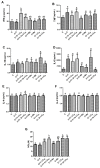A Trypsin Inhibitor from Moringa oleifera Flowers Modulates the Immune Response In Vitro of Trypanosoma cruzi-Infected Human Cells
- PMID: 32823803
- PMCID: PMC7460158
- DOI: 10.3390/antibiotics9080515
A Trypsin Inhibitor from Moringa oleifera Flowers Modulates the Immune Response In Vitro of Trypanosoma cruzi-Infected Human Cells
Abstract
Trypanosoma cruzi causes the lethal Chagas disease, which is endemic in Latin America. Flowers of Moringa oleifera (Moringaceae) express a trypsin inhibitor (MoFTI) whose toxicity to T. cruzi trypomastigotes was previously reported. Here, we studied the effects of MoFTI on the viability of human peripheral blood mononuclear cells (PBMCs) as well as on the production of cytokines and nitric oxide (NO) by T. cruzi-infected PBMCs. Incubation with MoFTI (trypsin inhibitory activity: 62 U/mg) led to lysis of trypomastigotes (LC50 of 43.5 µg/mL) but did not affect the viability of PBMCs when tested at concentrations up to 500 µg/mL. A selectivity index > 11.48 was determined. When T. cruzi-infected PBMCs were treated with MoFTI (43.5 or 87.0 µg/mL), the release of the pro-inflammatory cytokine TNF-α and INF-γ, as well as of NO, was stimulated. The release of the anti-inflammatory cytokine IL-10 also increased. In conclusion, the toxicity to T. cruzi and the production of IL-10 by infected PBMCs treated with MoFTI suggest that this molecule may be able to control parasitemia while regulating the inflammation, preventing the progress of Chagas disease. The data reported here stimulate future investigations concerning the in vivo effects of MoFTI on immune response in Chagas disease.
Keywords: Moringa oleifera; cytokines; cytotoxicity; immunomodulatory agent; protease inhibitor; trypanocidal agent.
Conflict of interest statement
The authors declare no conflict of interest. The funders had no role in the design of the study; in the collection, analyses, or interpretation of data; in the writing of the manuscript, or in the decision to publish the results.
Figures





References
-
- World Health Organization Chagas Disease. [(accessed on 20 June 2020)]; Available online: http://www.who.int/en/news-room/factsheets/detail/chagas-disease-(americ...
-
- Ferreira A.M., Damasceno R.F., Monteiro-Junior R.S., Oliveira I.A.C.D., Prates T.E.C., Nunes M.C.P., Haikal D.S.A. Reações adversas ao benzonidazol no tratamento da Doença de Chagas: Revisão sistemática de ensaios clínicos randomizados e controlados. Cad. Saúde Colet. 2019;27:354–362. doi: 10.1590/1414-462x201900030456. - DOI
Grants and funding
- 408789/2016-6/Conselho Nacional de Desenvolvimento Científico e Tecnológico
- Finance Code 001/Coordenação de Aperfeiçoamento de Pessoal de Nível Superior
- APQ-0108-2.08/14/Fundação de Amparo à Ciência e Tecnologia do Estado de Pernambuco
- APQ-0661-2.08/15/Fundação de Amparo à Ciência e Tecnologia do Estado de Pernambuco
LinkOut - more resources
Full Text Sources

